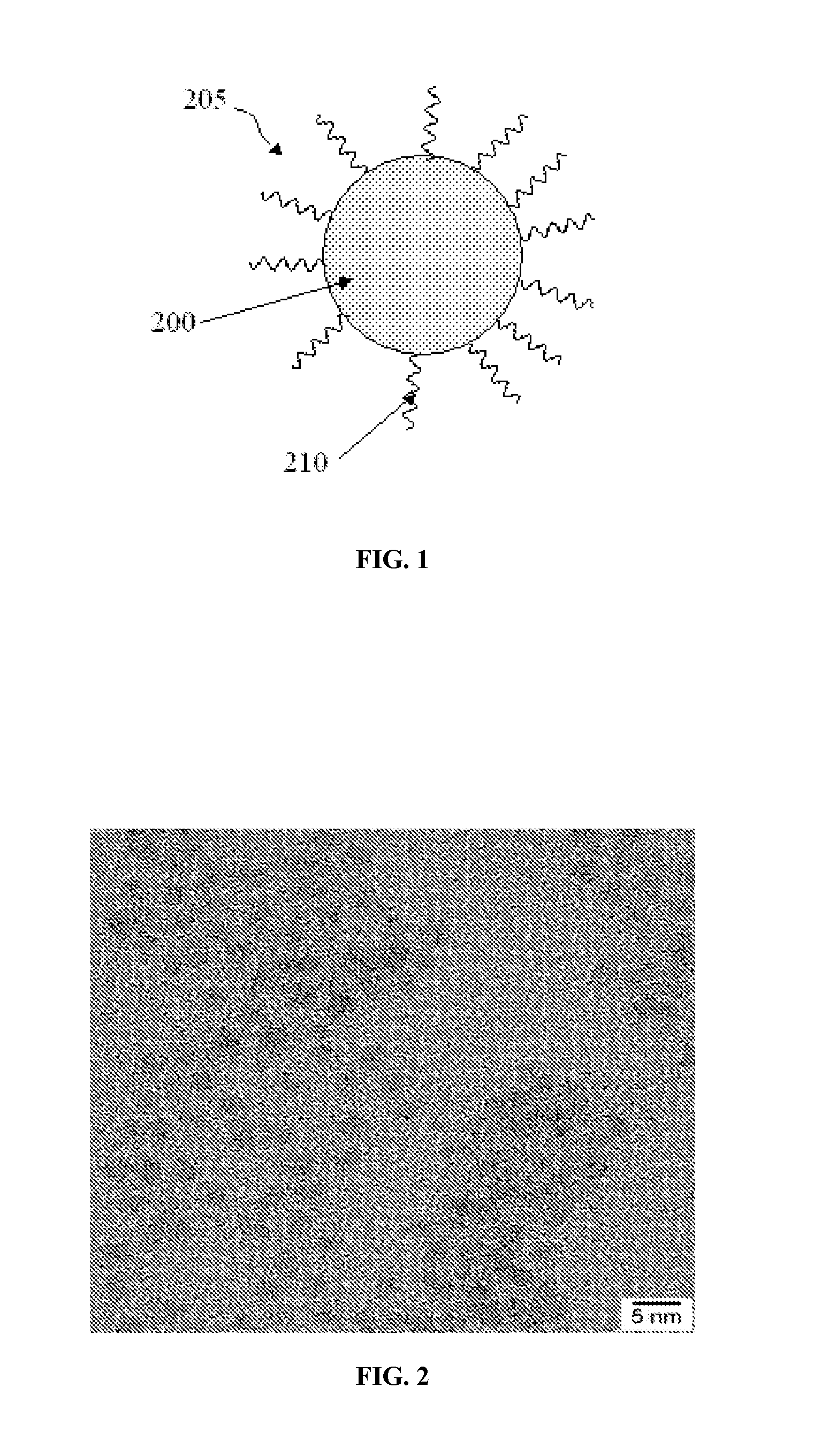Indium phosphide colloidal nanocrystals
- Summary
- Abstract
- Description
- Claims
- Application Information
AI Technical Summary
Benefits of technology
Problems solved by technology
Method used
Image
Examples
example 1
[0054]All three synthetic examples below were performed using a standard Schlenk line.
InP Nanocrystals
[0055]0.12 g (0.52 mmol) myristic acid, 0.022 g (0.05 mmol) zinc undecylenate and 7 ml 1-octadecene (ODE) were loaded into a three-neck flask. The mixture was degassed at 100° C. for 2 hours and pump-purged under N2 three times. After switching to N2 overpressure, the flask contents were taken up to 310° C., and the precursor solution of 0.024 g (0.15 mmol) trimethylindium (In(Me)3), 0.019 g (0.075 mmol) tris(trimethylsilyl)phosphine (P(TMS)3), 0.1 mmol octylamine and 2 ml ODE, prepared beforehand in a dry box, was added into the hot mixture by immediate injection from a syringe. After the injection, the reaction mixture was stirred at 270° C. for 6 minutes. The reaction was then stopped by removing the heating source.
example 2
InP / ZnSe Nanocrystals
[0056]0.12 g (0.52 mmol) myristic acid, 0.044 g (0.1 mmol) zinc undecylenate and 7 ml 1-octadecene (ODE) were loaded into a three-neck flask. The mixture was degassed at 100° C. for 2 hours and pump-purged under N2 three times. After switching to N2 overpressure, the flask contents were taken up to 310° C., and the precursor solution of 0.024 g (0.15 mmol) trimethylindium (In(Me)3), 0.019 g (0.075 mmol) tris(trimethylsilyl)phosphine (P(TMS)3), 0.1 mmol octylamine and 2 ml ODE, prepared beforehand in a dry box, was added to the hot mixture by immediate injection from a syringe. After the injection, the reaction mixture was stirred at 270° C. for 6 minutes. The reaction was then stopped by removing the heating source. After the flask was cooled down to room temperature, 0.069 g (0.376 mmol) zinc acetate was added and the mixture was annealed under N2 overpressure at 240° C. for 2.5 hours. After the anneal, the temperature was lowered to 230° C. A solution of 30 mg...
example 3
InP / ZnS Nanocrystals
[0058]0.12 g (0.52 mmol) myristic acid, 0.033 g (0.15 mmol) zinc undecylenate and 7 ml 1-octadecene (ODE) were loaded into a three-neck flask. The mixture was degassed 100° C. for 2 hours and pump-purged under N2 three times. After switching to N2 overpressure, the flask contents were taken up to 310° C., and the precursor solution of 0.024 g (0.15 mmol) trimethylindium (In(Me)3), 0.019 g (0.075 mmol) tris(trimethylsilyl)phosphine (P(TMS)3), 0.1 mmol octylamine and 2 ml ODE, prepared beforehand in a dry box, was added to the hot mixture by immediate injection from a syringe. After the injection, the reaction mixture was stirred at 270° C. for 6 minutes. The reaction was then stopped by removing the heating source.
[0059]After the flask was cooled down to room temperature, 0.069 g (0.376 mmol) zinc acetate was added and the mixture was annealed at 240° C. for 2.5 hours. After the anneal, the temperature was lowered to 230° C. A solution of 12 mg (0.38 mmol) sulfur ...
PUM
 Login to View More
Login to View More Abstract
Description
Claims
Application Information
 Login to View More
Login to View More - R&D
- Intellectual Property
- Life Sciences
- Materials
- Tech Scout
- Unparalleled Data Quality
- Higher Quality Content
- 60% Fewer Hallucinations
Browse by: Latest US Patents, China's latest patents, Technical Efficacy Thesaurus, Application Domain, Technology Topic, Popular Technical Reports.
© 2025 PatSnap. All rights reserved.Legal|Privacy policy|Modern Slavery Act Transparency Statement|Sitemap|About US| Contact US: help@patsnap.com



